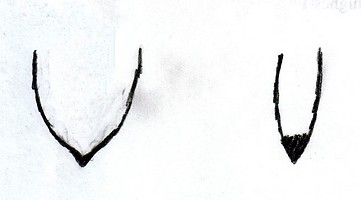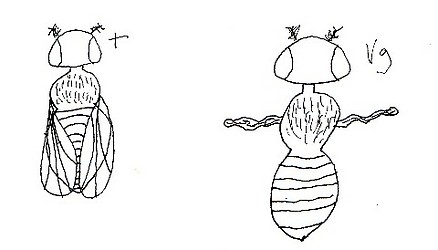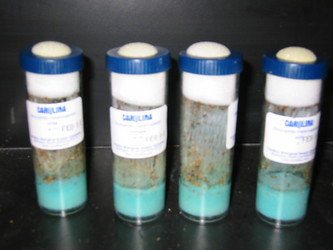Introduction
Our class is doing a lab which focuses on the genetic mutations in fruit flies. We are using fruit flies because they are easy to breed and it is easier to tell which genetic mutation that they have. Our group is focusing on the mutation Vestigial, which is a mutation of the wings. The mutation causes the flys wings to shrivle and become useless.
ClassificationKingdom- Animalia
- Phylum- Arthropoda. Jointed extensions called apendages, segmented, exoskeleton, cephalization, open circulatory system.
- Class- Insecta. Divided into 3 tagmeta, mandables, antenna, abdomine composed of 9-11 segments
- Order- Diptera. 1 pair of wings, sucking, peircing, or lapping mouth parts
- Family- Drosophilidae.The Family of small Fruit flies and vinegar flies
- Genus- Drosophilia
- Species- melongaster
- Genus- Drosophilia
- Family- Drosophilidae.The Family of small Fruit flies and vinegar flies
- Order- Diptera. 1 pair of wings, sucking, peircing, or lapping mouth parts
- Class- Insecta. Divided into 3 tagmeta, mandables, antenna, abdomine composed of 9-11 segments
Phenotypes
+: Have red eyes, their wings are normal, and they can fly and are bacically normal flies.
Vg: They have red eyes, their wings are shrivled and useless, they cant fly at all. Our group fondly calls these "walks" insted of flies.

Fly log
3/16, vial 1, there are 2 females 5 males active vial 2, one dead fly active 4 males zero females.
3/17, vial 1, no larva vial 2, 1 dead fly pretty much the same as the day before.
3/21, vial 1, they all died, vial 2, they all died.
3/24, vial 1, not using vial 1 any more because all the flies keep dying in this vial., vial 2, 6 males are still alive. Everyone is lively and the medium looks good.
3/27, all flies are still alive. no larva yet, medium looks brown
3/30, there is larvae, all the flies are still alive.
3/31, lots more larvae. flies are starting to die, no pupa.
4/3, Lots of pupae. no pupae have hatched yet. There is still larvae.
4/7, the medium was a little dry, still some pupae.
4/17, lots of flies in vial 2. only 3 flies in vial 1. Lots of pupae in vial 1.
4/21, lots of flys hatched. some F3 larva. Some unhatched pupae still.
How to Sex Flies
When were learning how to sex the flies we used Fly-nap to put the flies asleep. We waiting for them to fall to the bottom of the vial and then we dumped them out onto a notecard and distinguished male from female. We found out if they were male or female by looking at their abdomens to see if there was a black dot on the bottom. If there was a black dot on the abdomen they were male, if there wasn't they were female.


The one on the left is female, the one on the right is male
© 2006 fivegreen2
F1 Predictions
In our F1 cross we crossed Vistigual (VG) and wild (+) fruit flys, we calculated all the outcomes possible, including if VG is dominant, and + is recessive, if + is dominant, and VG is recessive, if Vg is sex linked, dominant, and the mutation is on the male, if VG is sex linked, dominant, and the mutation is on the female, if + is sex linked, dominant, and on the male, and if + is sex linked, dominant, and on the female. Below are three of the possible outcomes, the first is not sex-linked and VG is dominant, the second is not sex linked, and if , is dominant, and the third is sex-linked, and the male is wild.
If VG Dominant
| VG | VG | |
| + | VG+ | VG+ |
| + | VG+ | VG+ |
| vg | vg | |
| + | +vg | +vg |
| + | +vg | +vg |
If WILD (+) is sex-linked and the male is wild
F1 outcome
For our F1 outcome all of our flies had the wild phenotype, which shows that wild is dominant and not sex-linked. Our mutation (vestigual wing) is autosomal recessive.
F2 predictions
For our F2 predictions, after gathering our F1 conclusion data, we figured out that there was only one way the fruit flies could cross, since it was not sex-linked, 25% of all F2's should all be VG and 75% should all be WILD
Punnet sqaure for F2 cross
| VG | + | |
| VG | VGVG | VG+ |
| + | VG+ | ++ |
Fly Final Counts
Vial 1: Female Wild:3 Male Wild:0 Female Vg:0 Male Vg:0
Vial 2: Female Wild:39 Male Wild:49 Female Vg:26 Male Vg:11
Percent error
Vial 1- vial 1 was unusable, the only flies that came out of it were 3 wild females
vial 2
| Phenotype | observed | expected | (O-E) | (O-E)/E | X 100 | % Error |
| Wild | 88 | 93.75 | 5.75 | .06133333... | 6.1333333... | 6.1 |
| VG | 37 | 31.25 | 5.75 | .184 | 18.4 | 18.4 |
Conclusion
Our hypothesis was supported by our data: vestigial wing in fruit flies is an autosomal recessive trait, and Wild wings is a dominant one, our percent error was very small, only 6.1 percent, showing we were very accurate. One of our vials was contaminated somehow, and we ended up with a very small amount of offspring. Next time we may take more precautions to make sure a vial is not contaminated, have more vials, and/or take more time outside of the classroom to work on it because we did run into some time issues.






 Go to quick links
Go to quick search
Go to navigation for this section of the ToL site
Go to detailed links for the ToL site
Go to quick links
Go to quick search
Go to navigation for this section of the ToL site
Go to detailed links for the ToL site